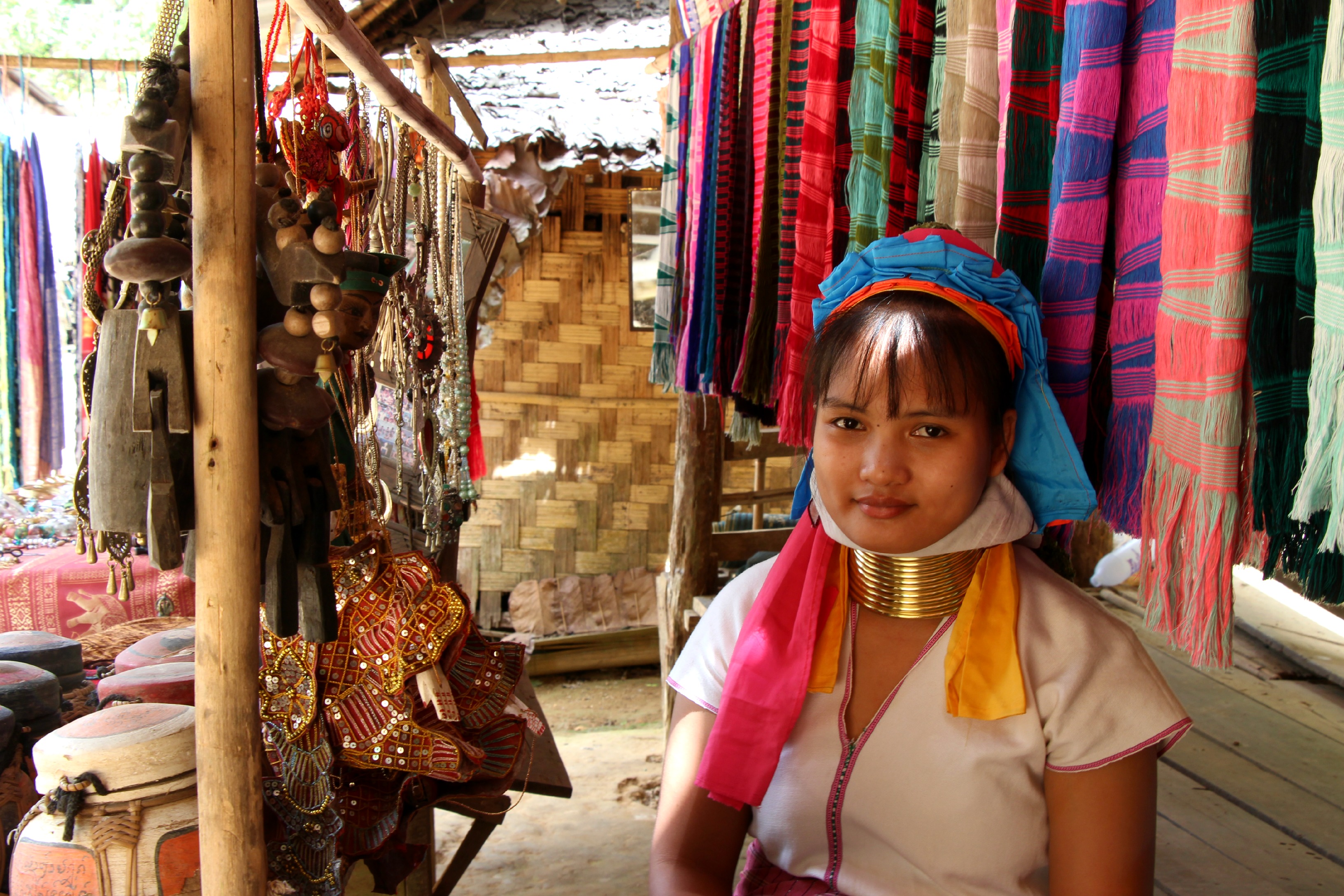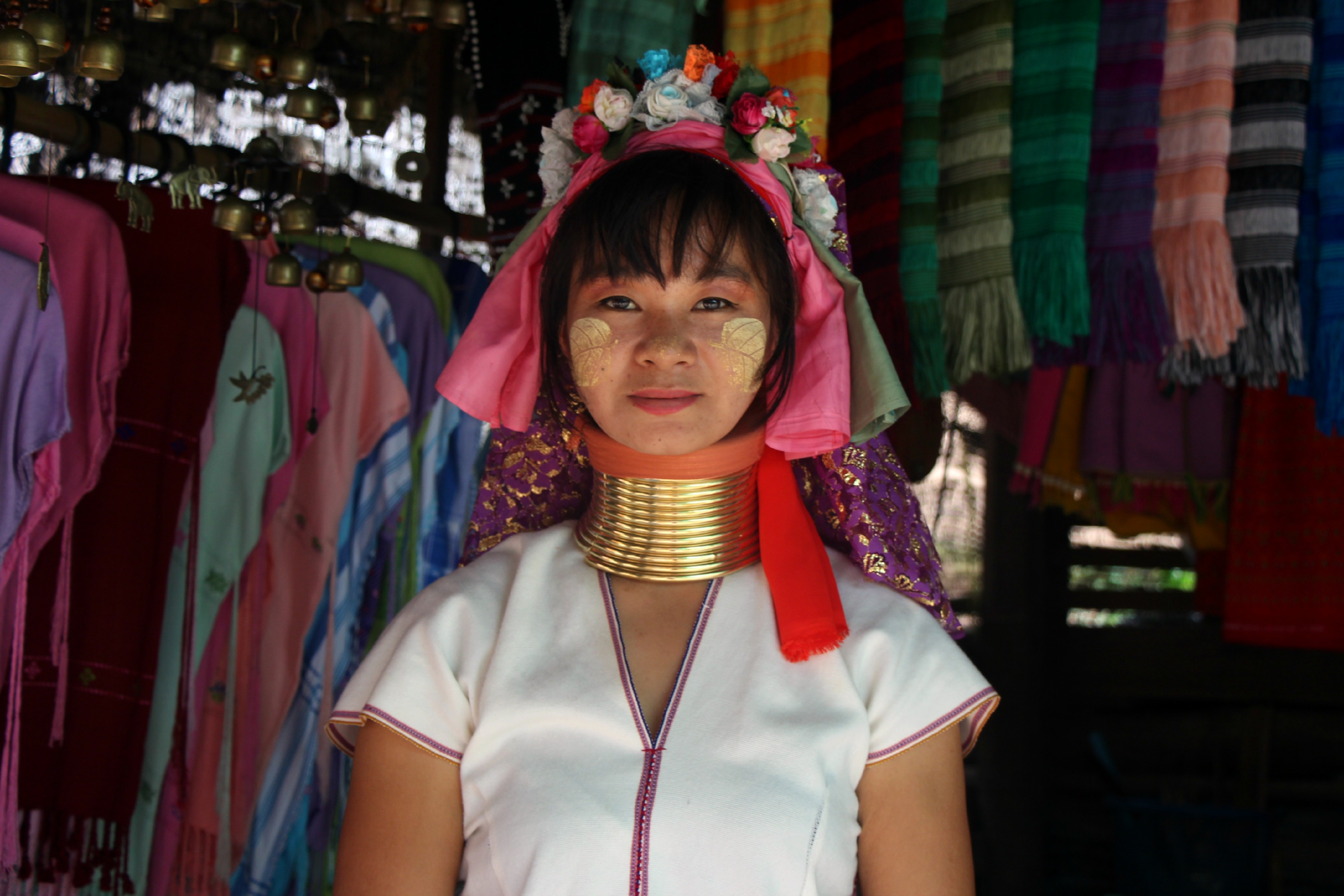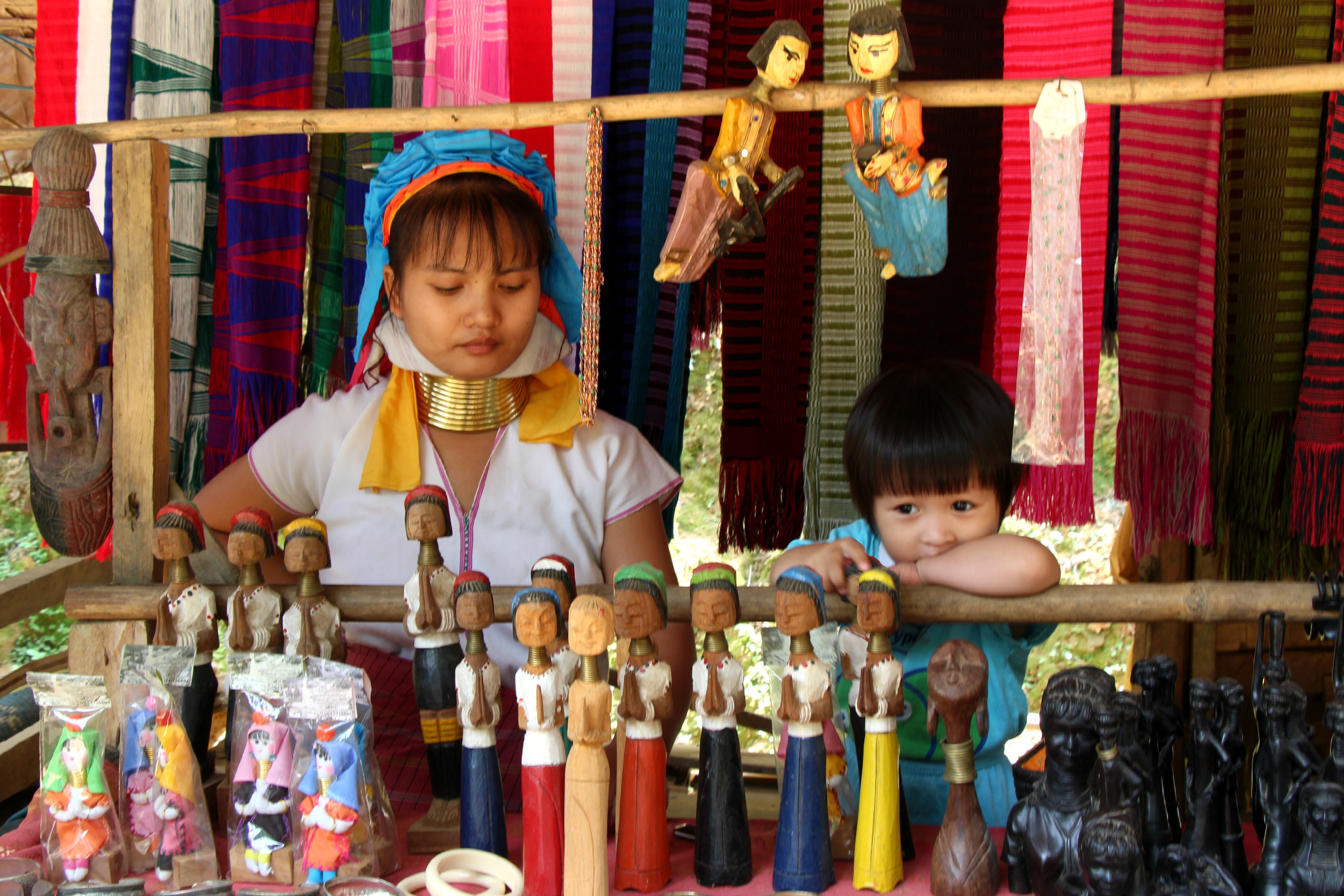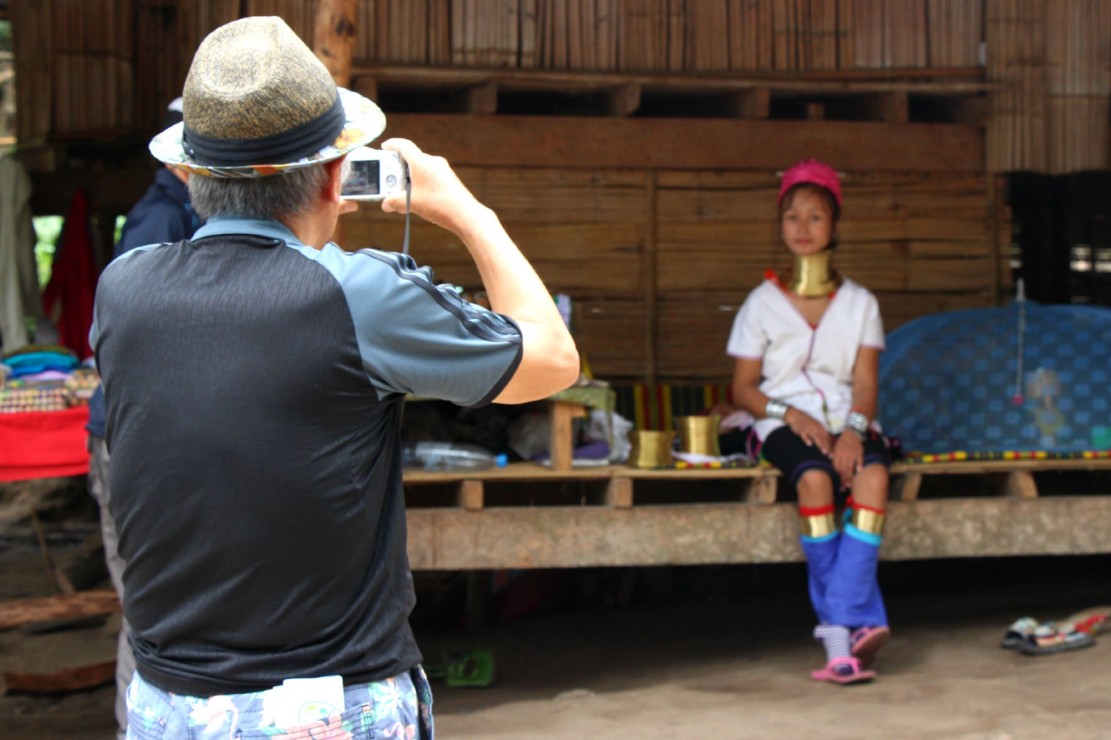[dropcap]P[/dropcap]ropped up by a set of brass coils encircling her neck, Mapaung’s head turns stiffly to survey the deserted village of Kayan Tharyar. Beyond the mountains in the background lies her homeland – Burma.
It’s another quiet day in the village. No more than five years ago, hordes of tourists would flock in by the busload to gawk at the women who live here, take photos and, with any luck, buy some souvenirs.
But now, amid continuing campaigns by human rights organisations and ethical tourism agencies to ‘Stop the Human Zoo’ in northwestern Thailand, the steady stream of visitors has dried up. And so has their money.
“Now, we are not getting so many tourists,” Mapaung complains, indicating a stack of untouched hand-woven scarves and knickknacks.
“This is no good, because we cannot sell our products.”

On the dusty afternoon that Mapaung sits pensively waiting for custom, only two foreigners came by. They briefly glanced around, took no pictures, and bought no souvenirs.
Marta Martinez, traveling from Spain with a friend, said that being in the village made her nervous and uncomfortable.
“We didn’t actually want to come here,” Martinez said, indicating that they got lost whilst following signs to another place.
“We don’t like it. This is like a zoo for people.”
Kayan Tharyar is now home to only two young women wearing the rings. Increasingly, more and more ethnic Padaung – known worldwide as ‘long-neck women’ – are choosing to move to better populated tourist spots, such as Chiang Mai in northern Thailand, where Mapaung’s mother and elder sister currently reside.

In the district of Mae Rim, some 40 minutes north of Chiang Mai – beyond a cavalcade of shooting ranges, ATV quad-biking tracks, monkey shows, bungee jumps, snake farms and elephant parks – is the Baan Tong Luang ‘hill tribes’ village.
The village advertises itself as an “eco-agricultural” project dedicated to “preserving the wonderful lifestyle” of the hilltribe people, and houses nine distinct ethnic tribes hailing from around northern Thailand, Burma and southern China.
The sprawling park provides a convenient one-stop shop for tourists eager to see exotic tribal peoples, without the bother of travelling to the various corners of Southeast Asia where these groups are native to. Tourists easily hop from the Yao people, indigenous to southern China, to the Hmong, originally from the mountain areas close to Laos, to the Padaung ‘long-necks’ in a single afternoon, all while snapping pictures to show off back home.

In their designated section, signposted “Kayang/Karen”, two girls play with their younger brother, kicking about a small unripe mango. As they hear a tour group approaching, five-year-old Moo and ten-year-old Ma-So hurry back behind their stalls ready to pose for the day’s sightseers. Moo has ten brass coils on her neck, her elder sister has 11, altogether a weighty load to carry on such young shoulders. Unadorned menfolk slink back into their houses, out of sight, and the women awkwardly re-adjust themselves in front of their weaving looms.
As they cannot speak much English, the Padaung women in Baan Tong Luang cannot properly explain their culture or their lives to the visiting groups. This job is left up to the Thai guide, and the women simply stare at the camera lenses pointed at them as they negotiate discounted prices for their wares.
After the tour groups have left, boys and girls run back onto the dirt streets to play, and the women quietly pocket the handful of tips they have earned for their afternoon’s work.

Members of this tribe, the Padaung (a sub-group of the Karen, also known as Kayan) originally hail from Burma and were forced to flee into neighbouring Thailand to escape armed conflict.
From the age of five or six, Padaung girls begin winding a series of heavy brass coils around their necks to give them an elongated appearance. The coils, weighing up to four or five kilograms by the time a woman reaches adulthood, push down on their collarbones and compress their ribcages, resulting in a cultural garb unique to the Padaung.
“It’s hard at first, but you get used to it,” Mapaung said, as she tugged slightly at the rings she has worn around her throat for 16 years.
While the origins of the tradition remain a mystery (some claim it was to protect the women from tigers, others that it was to prevent men from other tribes from carrying them off), Mapaung knows of only one purpose for her rings.
“It makes us beautiful, and it makes the tourists want to come and see us,” she said.
“My grandmother [wore the rings], my mother did it, and in the future, my daughter will.
“It is what we do.”

Non-governmental organisations, tour groups, and travel publications around the world decry these ‘tourist camps’ as an abuse of human rights and urge ethic-conscious tourists to boycott trips to the Padaung villages.
But Andrea Valentin, an expert in Burmese tourism, considers the ethics of the situation to be not so clear-cut.
“Community-based tourism shouldn’t be judged merely by ‘how much money do they make’ – it should be about exchanges, learning, and respectful interactions with different cultures. But this is not the case in the Kayan villages in Northern Thailand: tourists come, take pictures, maybe buy some stuff, then leave.
“Currently the only way most Kayan women make money is by selling handicrafts. So looking at this type of tourism from a socio-cultural perspective, it’s clear that it leads to an inhumane human zoo situation.”

Further muddying the issue is the refugee status of the women. The Padaung are recognised by agencies around the world as genuine refugees who have fled Burma’s 67-year-old civil war and are entitled to resettlement. However, as they are regarded one of Thailand’s most lucrative tourist attractions, Thai authorities are reluctant to let them leave.
In 2008, at least 20 Padaung tribespeople were prohibited from leaving Mae Hong Son, a popular tourist area in Thailand’s north home to three separate ‘long-neck’ villages, despite offers for resettlement in New Zealand and Finland. Thai officials claimed that the Padaung had been registered as an ethnic hilltribe, and were therefore ineligible for resettlement.
At the time, the BBC quoted a spokesperson from the United Nation’s refugee agency UNHCR as saying, “It’s absolutely a human zoo. One solution is for tourists to stop going.”

However, Valentin believes there are other solutions.
“Instead [of advocating a boycott of the villages], it could be more constructive to look at the root causes; the private tourism sector is the major beneficiary, but not the people on the ground. That’s the problem that needs to be addressed.
“Do your research and find responsible tour operators. Try to find out what kind of ethical community-based tourism projects are out there.
“If a community is well prepared for tourism, if processes are in place that ensure that a wide range of people benefit and are involved, then visiting such a community is ethical.”

Regardless of the intentions behind it, all the boycott boils down to for Mapaung is a shortage of cash.
“Everyone in the village depends on tourists,” she said.
“When the tourists come to look at us and take photographs, it makes me feel better because I know I will have some money.”



